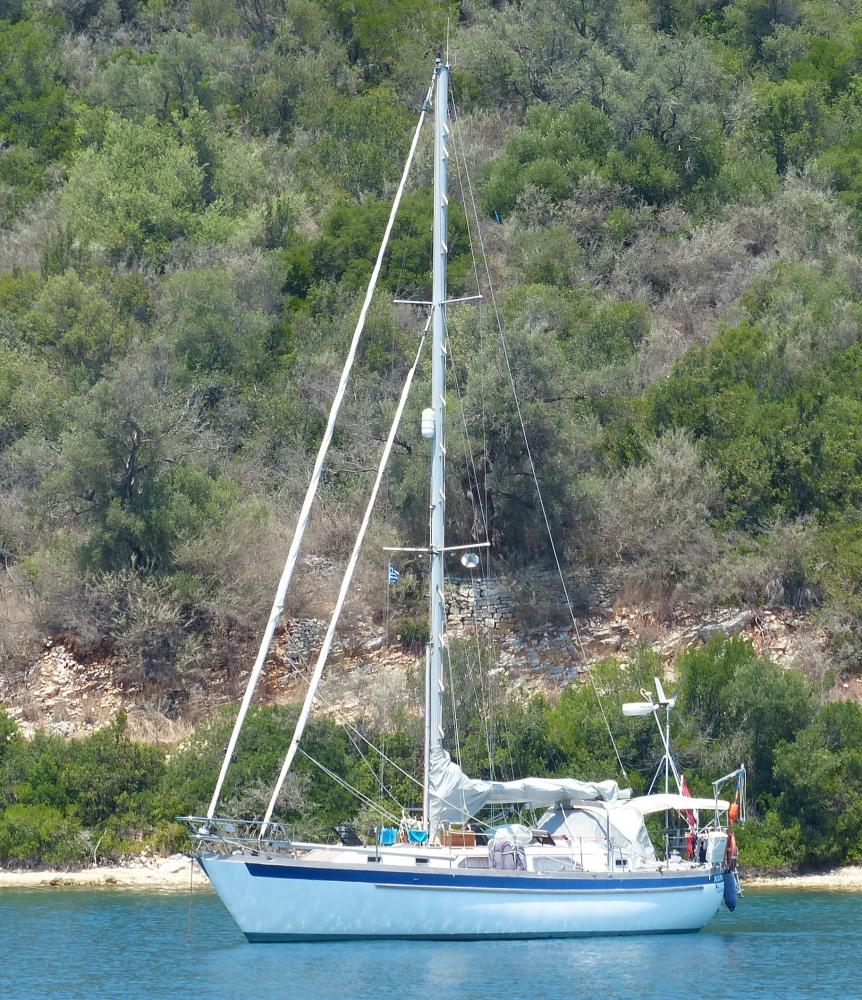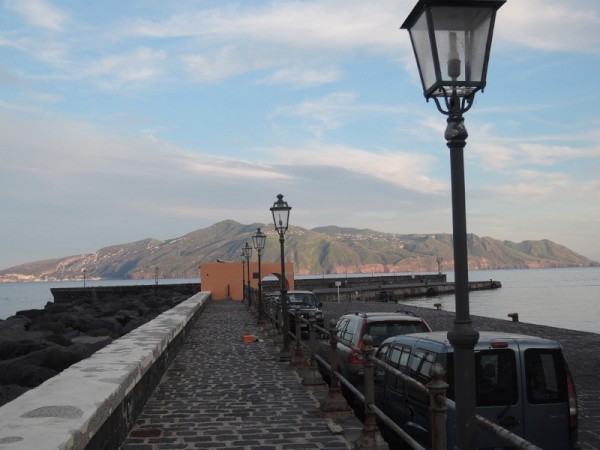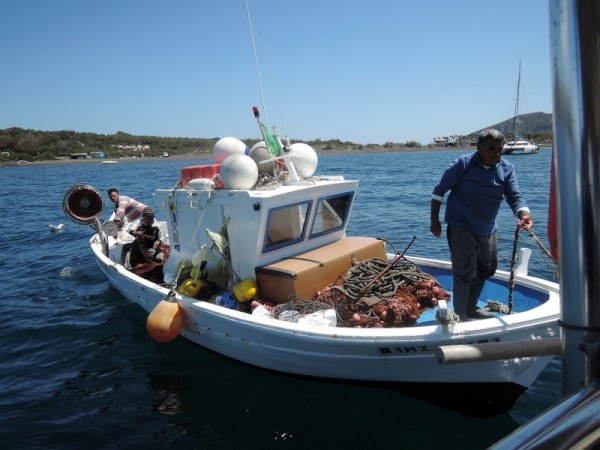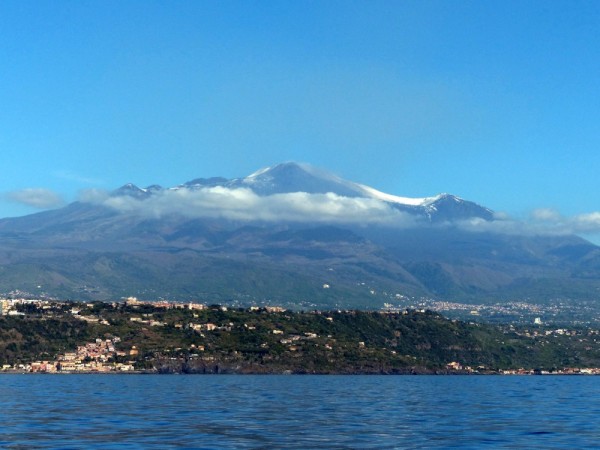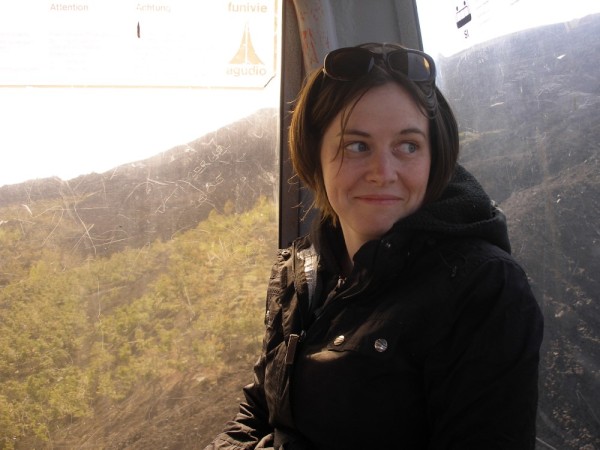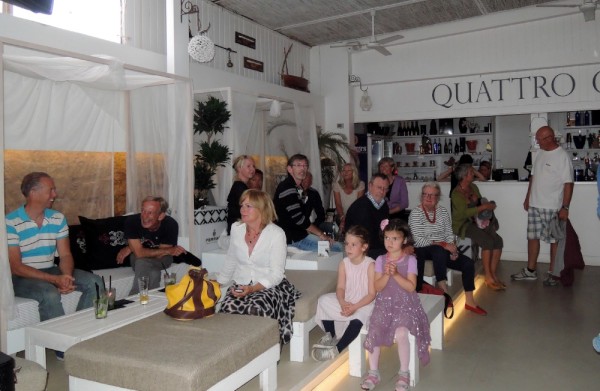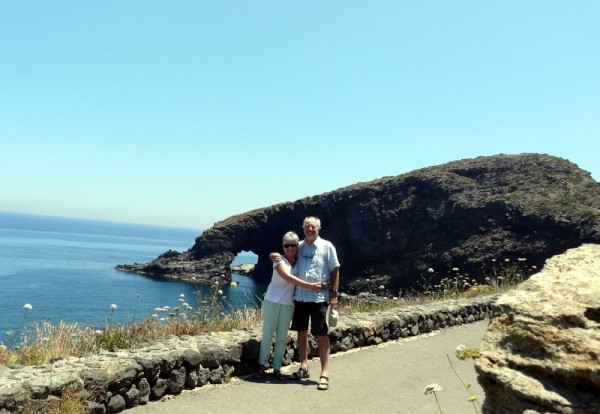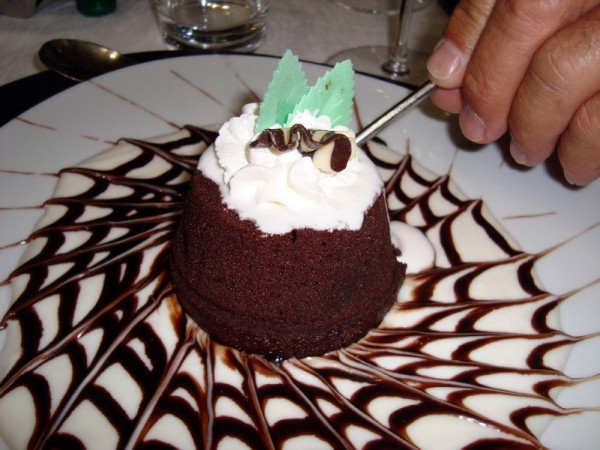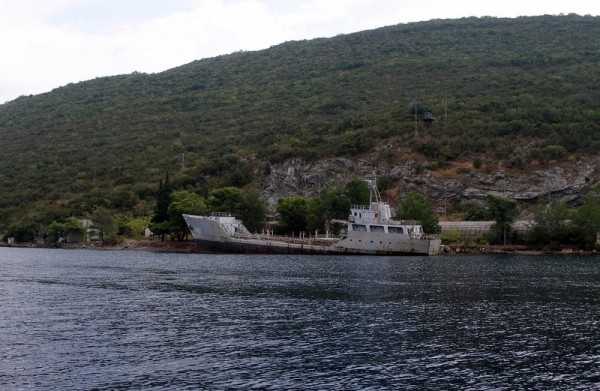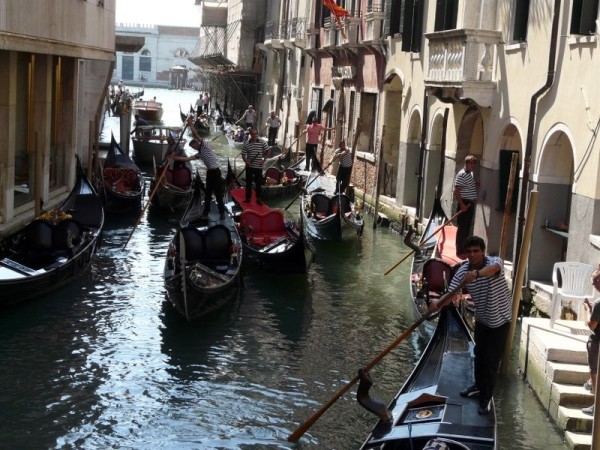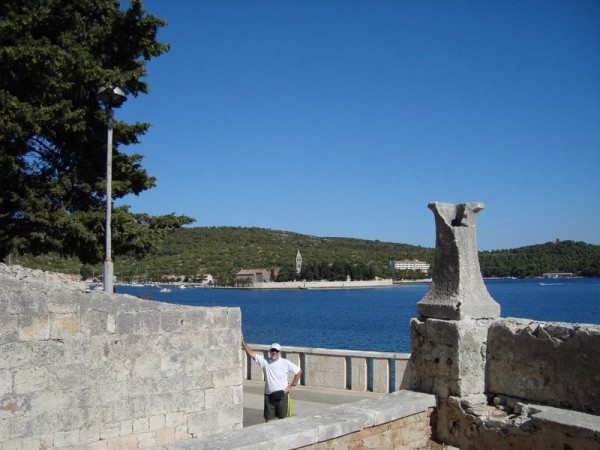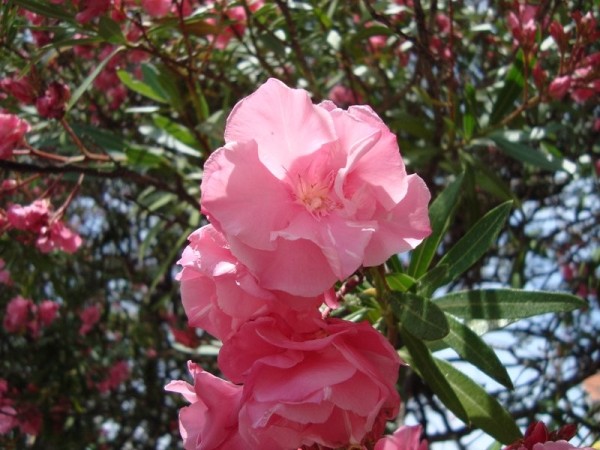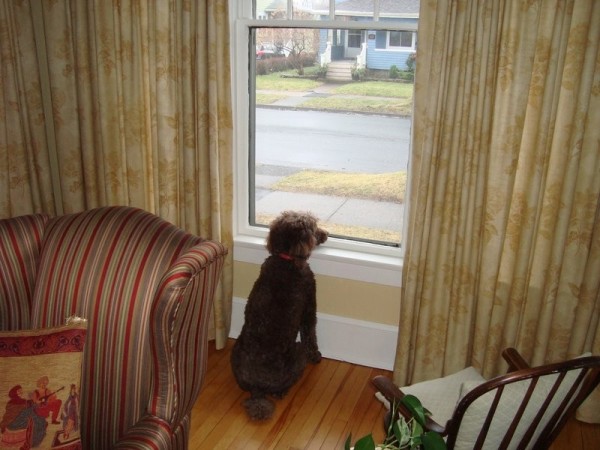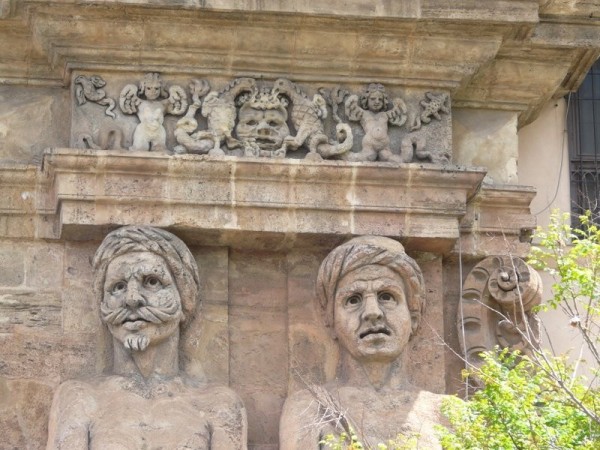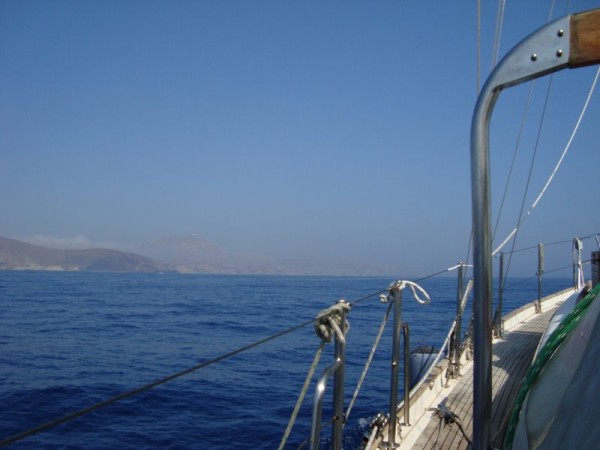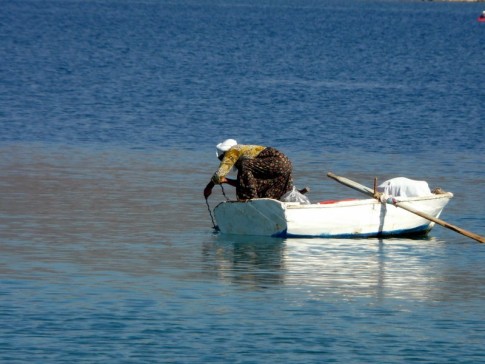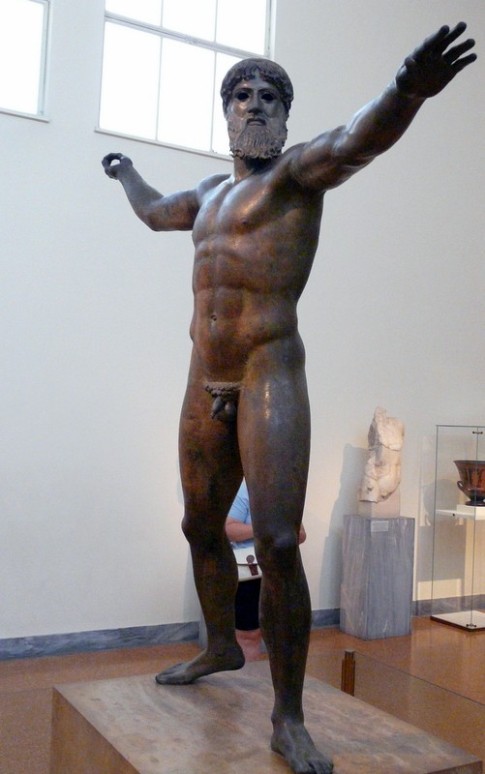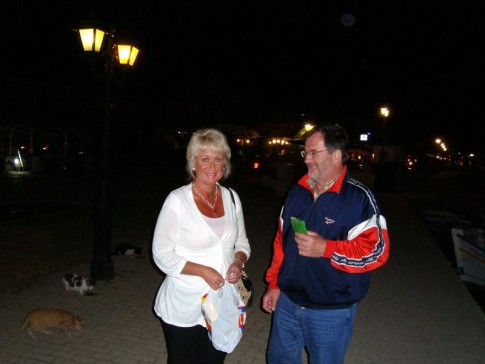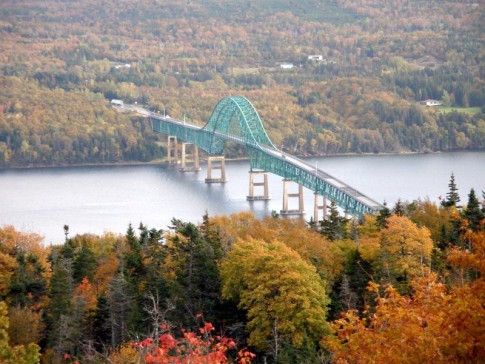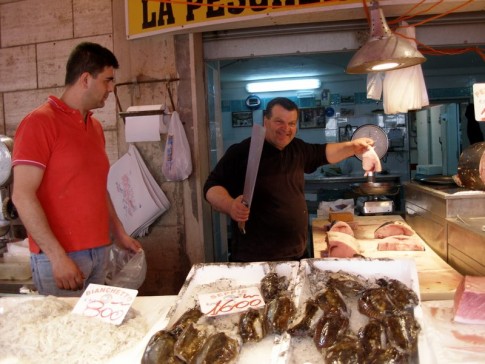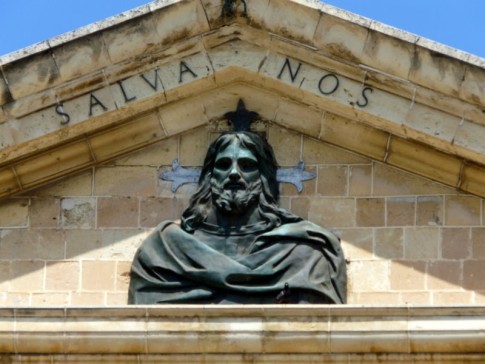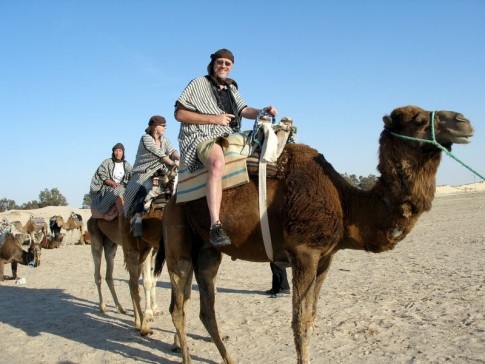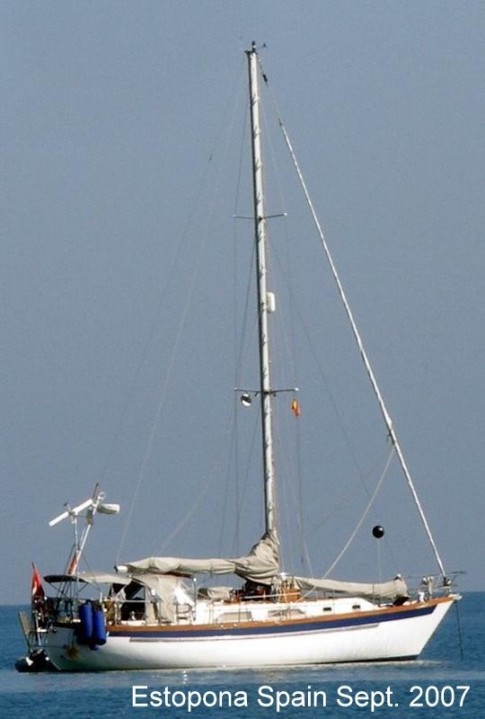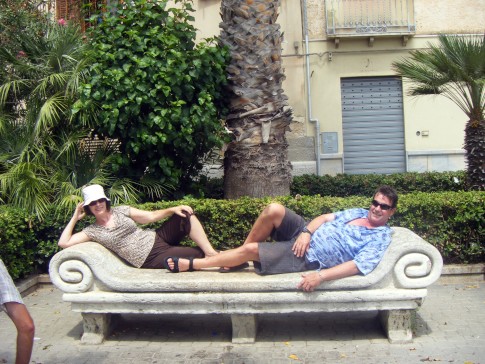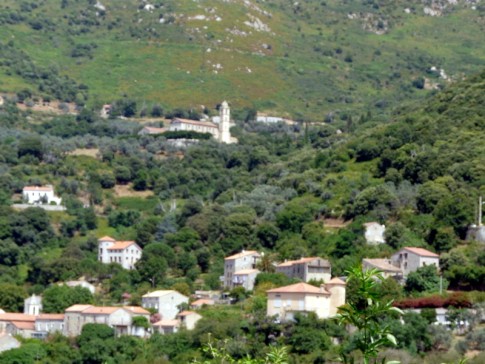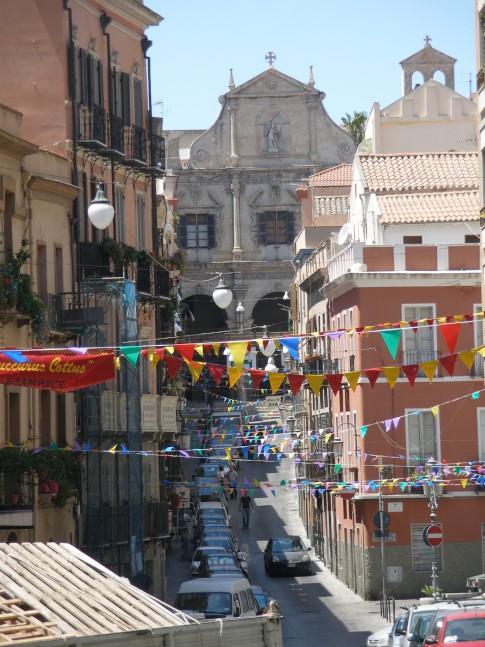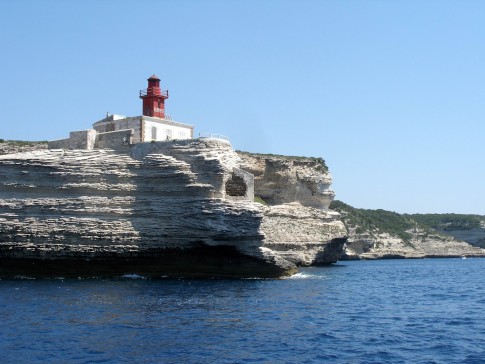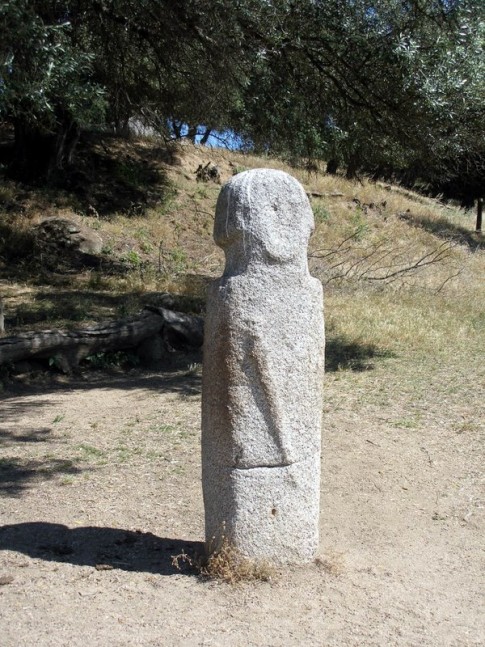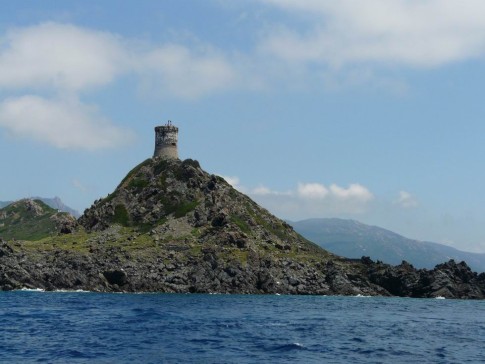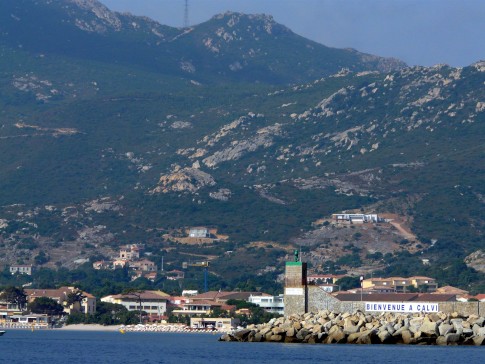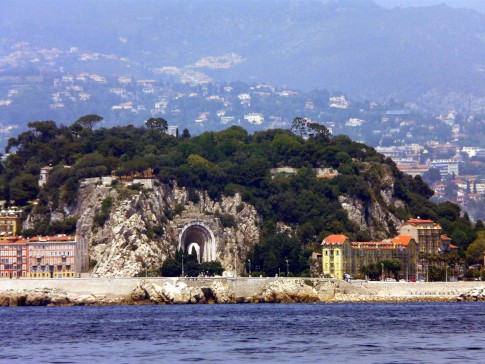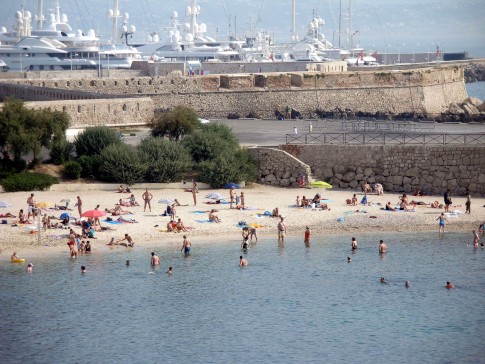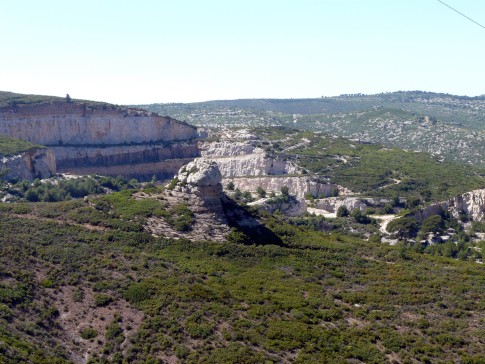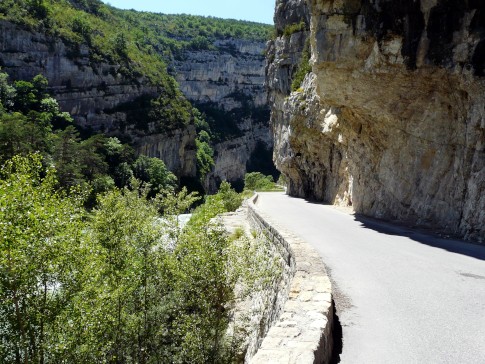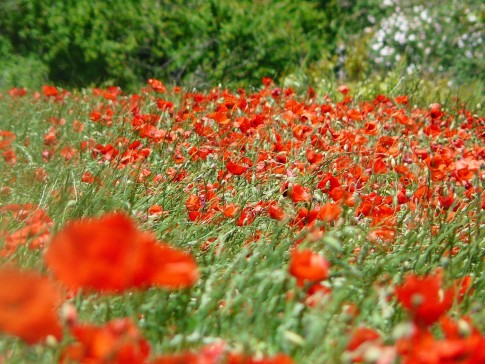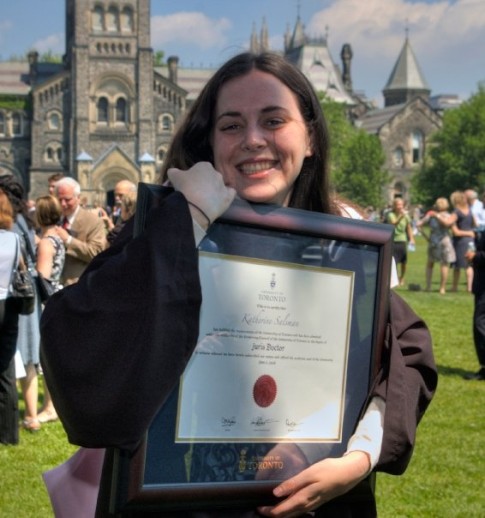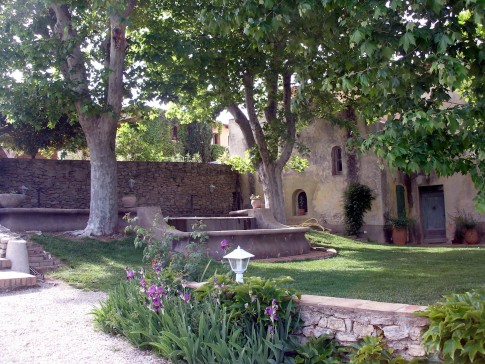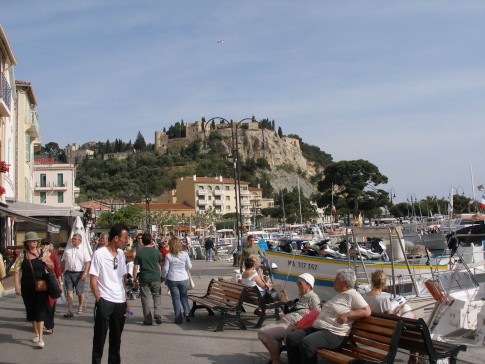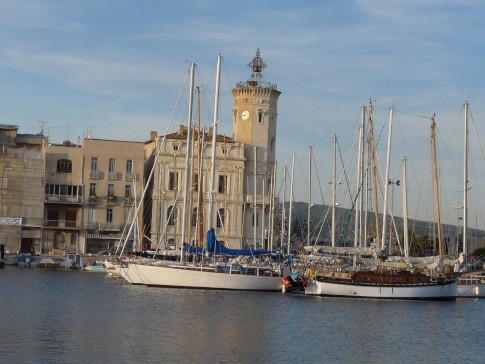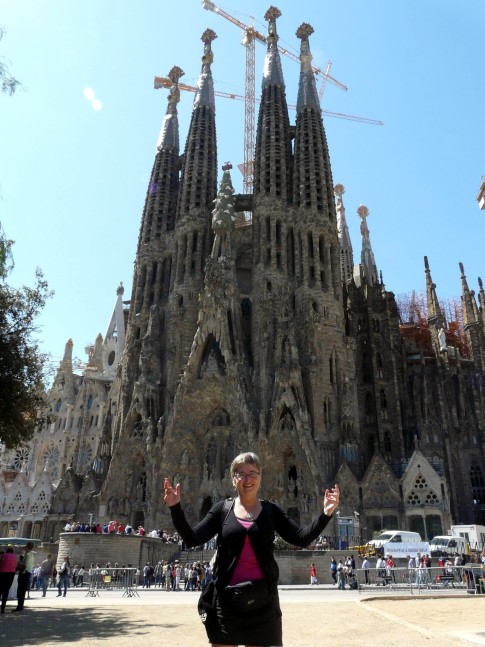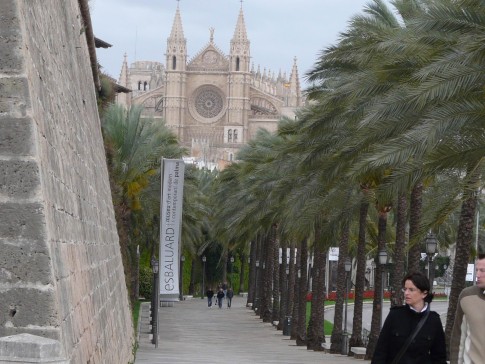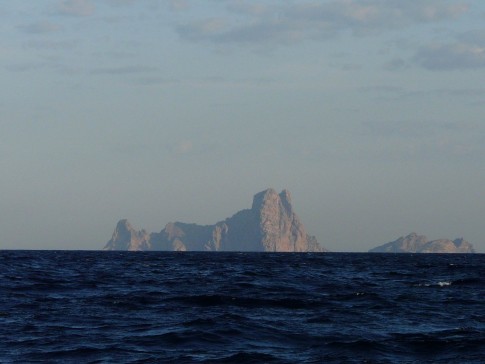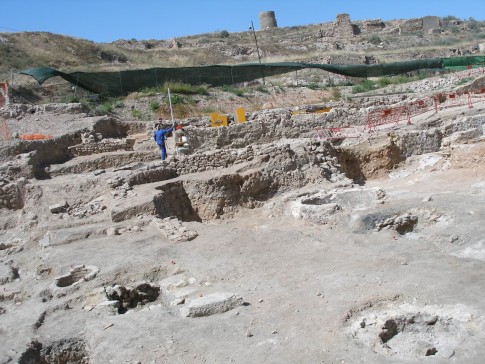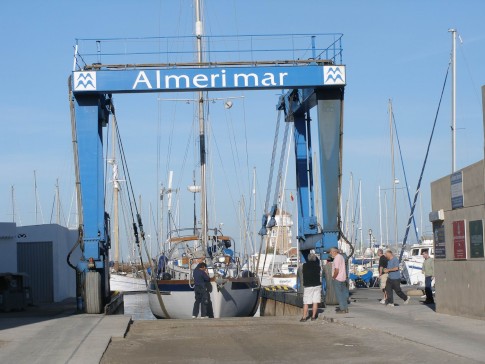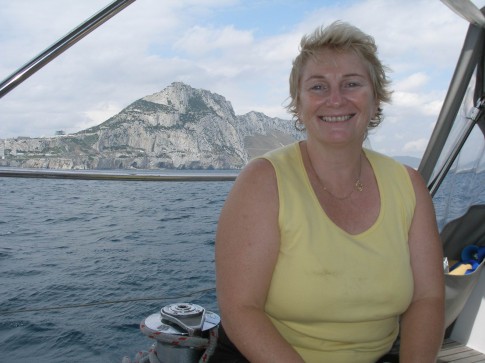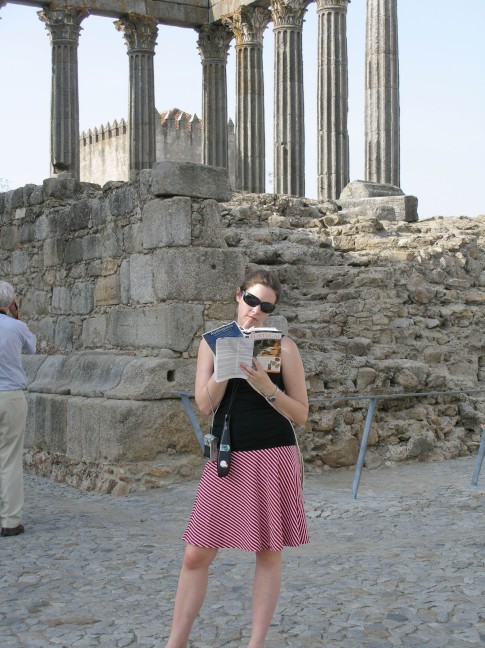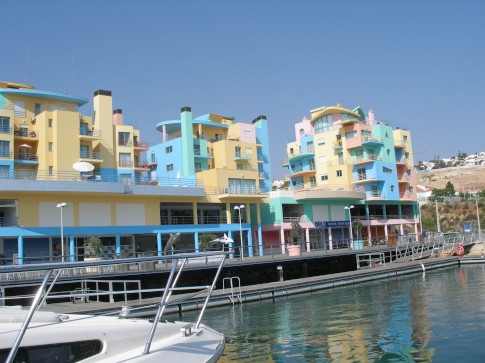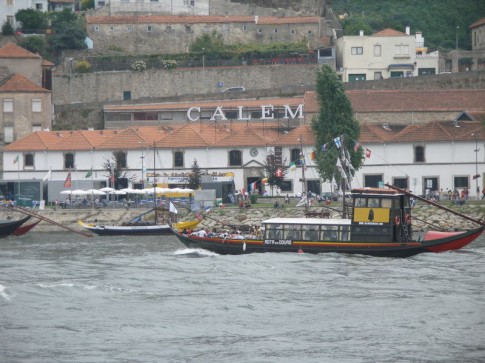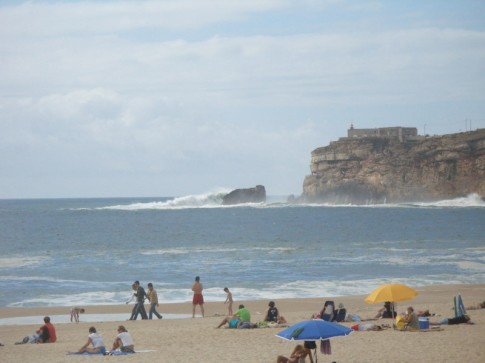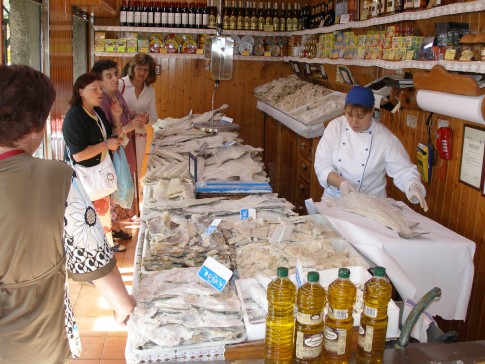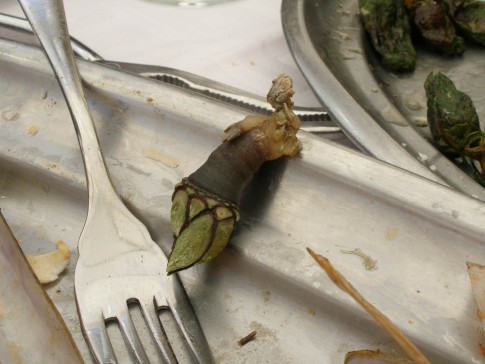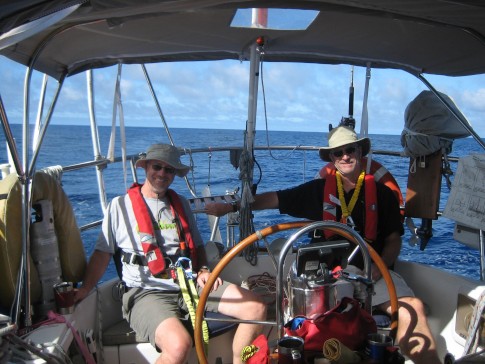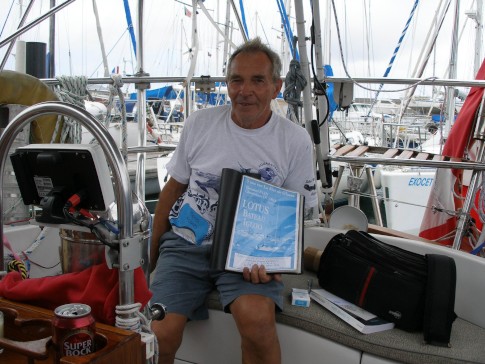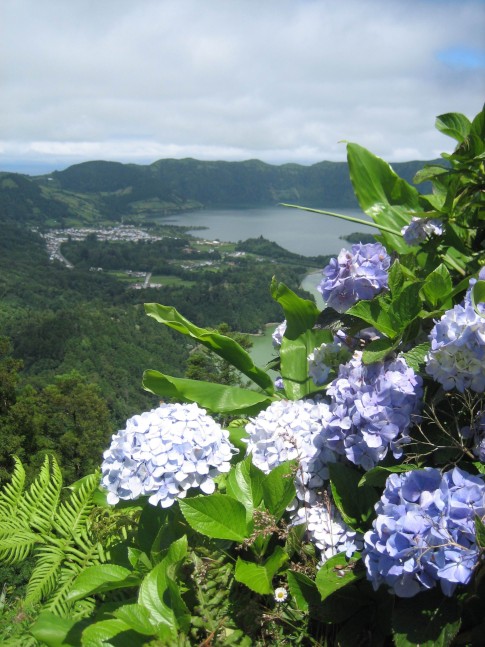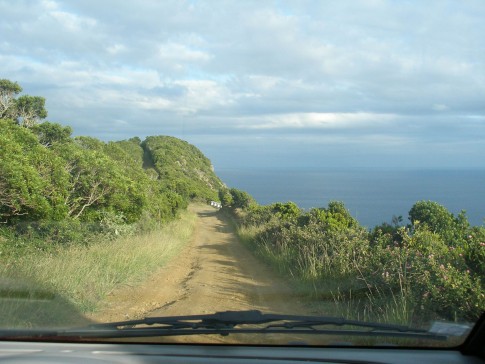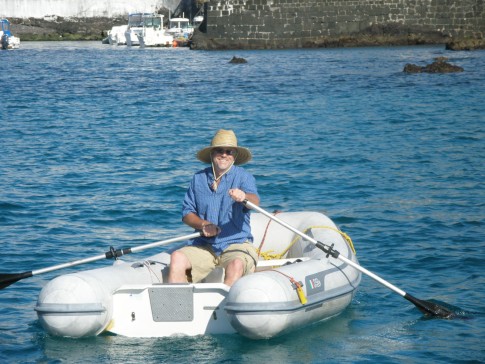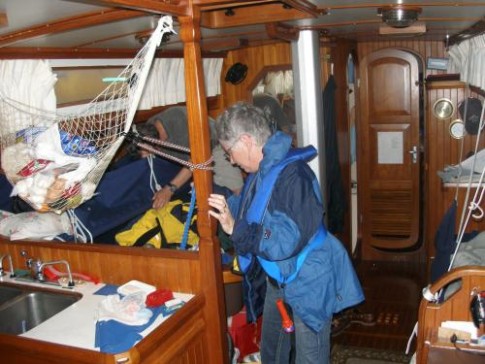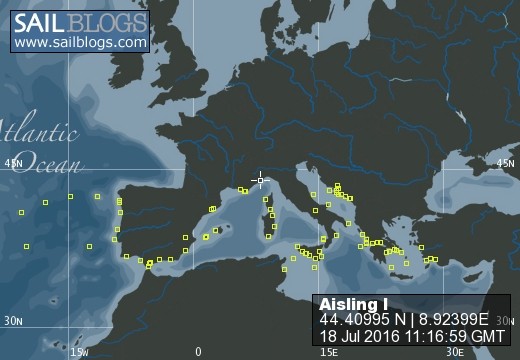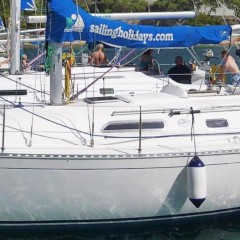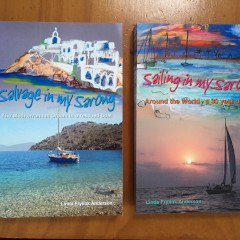
Aisling I
18 July 2016 | Genoa
11 July 2016 | Genoa Italy
04 July 2016 | Genoa
02 July 2016 | Genoa
25 June 2016 | Porto Azzurro Elba
11 April 2016 | Marina di Ragusa
21 March 2016 | Halifax
01 March 2016
14 January 2016
30 September 2015
25 September 2015 | Crotone Italy
18 September 2015 | Erikoussa
10 September 2015 | Preveza
10 September 2015 | Preveza
24 July 2015 | Preveza
20 July 2015 | Varko Bay
13 July 2015 | Vlicho Bay
09 July 2015
03 July 2015 | Preveza Greece
21 June 2015
Finally, Ephesus!
26 June 2011 | At anchor in Porto Helli
Bonnie and Rick
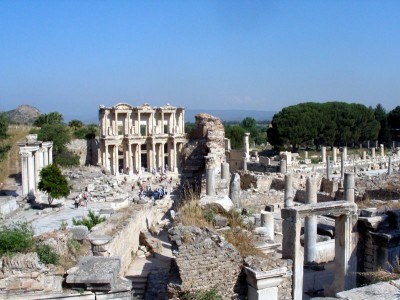
Have you ever noticed how you can get a sense of just how impressive a place or a work of art is, just by studying the expression on a person's face as they describe it to you? I have never forgotten the face of a Scottish man names Alastair who described Ephesus to us as we sat drinking cappuccino together in a small café in Syracuse, Sicily. After speaking with him, I immediately added Ephesus to my list of "places to see before I die". On our third visit to Turkey, we are finally managing to see it.
Taking Gerry and Anne's advice, we plan to arrive at the Ephesus gate just as the site opens. On the road, we debate the pros and cons of entering at the upper or lower gate. If we enter at the upper gate, we can walk downhill to explore the site but will face a hot uphill climb to get back to the car. Instead, we opt to enter at the main gate and walk uphill to explore the site, so that the return journey will be downhill. (As it turns out the hill is not that big and the issue of where to start would be of more interest to seniors than to us. Oops...maybe we are seniors!) The gate attendant predicts that it will be a quiet day, since it is a Sunday, and also election day in Turkey. As we enter the site and walk along the marble Sacred Way, we have the site almost entirely to ourselves. Since Ephesus is one of the busiest tourist sites in Turkey, this is almost completely unheard of.
It was no surprise to hear that St. Paul spoke to a crowd of over 25,000 in the Ephesus theatre. Paul took his job seriously and really did get around, but initially he was not well received by the Ephesians. The silversmiths certainly didn't appreciate his fiery diatribes against the idols and graven images that were their stock in trade. After Paul's appearance, there was a huge protest in the streets of Ephesus, with demonstrators chanting "Artemis is great!" Artemis, twin of Apollo, was the goddess of the hunt and the moon. Her massive, many-breasted statue in the temple outside Ephesus (one of the Seven Wonders of the Ancient World) must have been a truly awe-inspiring sight.
The graceful Library of Celsus is easily recognizable from the many photos we have seen on postcards, in guidebooks and in the photo albums of friends. It originally held over 12,000 scrolls, stored in niches in the walls. The façade is decorated with statues representing the four virtues. To see the original statues you will have to go to Vienna. (Don't get me started...) It seems almost surreal to be there with no one else in sight. Rick sets up his tripod and takes our photograph using the timer on his camera. It's a long way to the top of the steps, so he has to make a run for it!
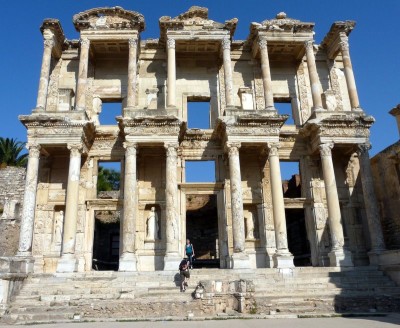
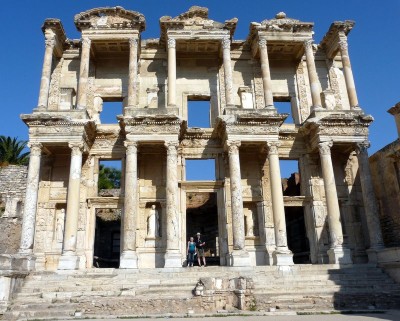
Eventually, a young German man appears. "You had better let us take your picture on the steps" I say, "You probably won't get a chance like this again". He tells us that this is his third time visiting Ephesus, but he has never before been there in the morning, when the sun illuminates the buildings so perfectly.
Turn back the clock two thousand years. No electricity, no internet, no automobiles. But the wealthy did have running water, baths, toilets, chariots, and beautifully-decorated homes that were nearly as comfortable as ours are today. The long row of seats in the men's public toilets was originally positioned over a latrine that was flushed by an uninterrupted flow of water. The nearby brothel was the original location of the X-rated statue of Priapus now on display in the Ephesus museum. A heart and footprint etched into a marble stone on Curetes St. point the way to the brothel.
As we climb uphill, we inevitably meet the bus-tour crowds making their way downhill. Some groups have two guides, with one guide providing information in English and the second guide doing simultaneous translation in another language. The guide for a French group is doing double duty as a comedian and the sound of uproarious laughter echoes through the site. As we cross paths with them, the guide is brandishing one of the huge thorny plants that grow wild on the roadside. "This is a narthex plant" he says. "The same word as the entrance to a church". Then I lose the thread, but he seems to be saying that the plants were carried in processions and burned at the entrance to temples. (Does anyone know? If so, please post a comment.) Another guide is giving water to one of the feral cats that roam the site- how do they survive?
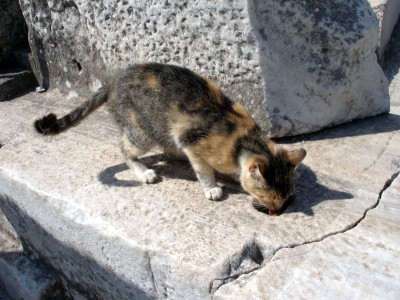
The site is too extensive to describe here, but the highlight of our day is a tour of the "Terrace Houses". Dating back to the 1st-7th centuries AD, these houses are remarkably intact. More and more of the broken bits are being reassembled like jigsaw puzzles in a joint project of the Turkish and Austrian governments.
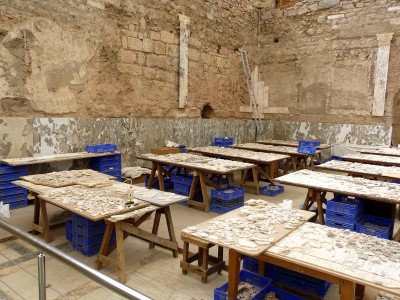
These multi-storied houses were part of a large, luxurious apartment complex built into the mountainside. The houses were obviously occupied by elite of Ephesians; the stenciled walls and mosaic floors are works of art. Contemplating how many years have passed since the original inhabitants decorated these houses inevitably leads to the sinking realization of how short our time on earth really is. Two thousand years from now, will anything be left to tell the story of our civilization?
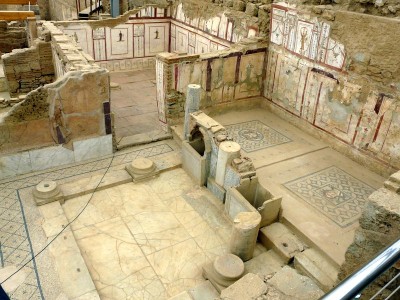
It has taken us four hours to tour the site and we are almost out of time because the rental car is due back at 2 o'clock. We pass the gift shops at the gate, where the same candle holder that I bought for 30 lira at Miletus is on sale for 48 euros. A young American back-packer is scoffing at the prices of the "Genuine Fake Watches". " I'll buy my watches in Vietnam!" he tells the vendor.
We debate our next stop- a pide restaurant or the Basilica of St. John? The Basilica wins. There is little left of the original building, which at one time was a massive, glorious cathedral with the tomb of St. John (who by some accounts lived to be 100 years old) positioned under the dome. From the walls of the basilica, we can see the single surviving pillar of the wondrous Temple of Artemis, standing in a field in the distance. It is as close as we will get.
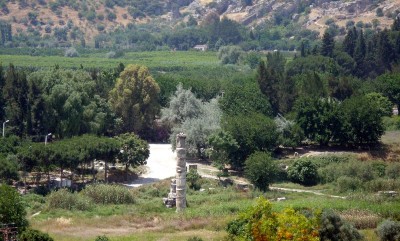
This is the end of our tour of Turkey, at least for this time. The next day, we decide to cross over to the Greek island of Samos and begin gradually making our way across the Aegean. "Gorusuruz" Turkey, I hope we will see you later!
Taking Gerry and Anne's advice, we plan to arrive at the Ephesus gate just as the site opens. On the road, we debate the pros and cons of entering at the upper or lower gate. If we enter at the upper gate, we can walk downhill to explore the site but will face a hot uphill climb to get back to the car. Instead, we opt to enter at the main gate and walk uphill to explore the site, so that the return journey will be downhill. (As it turns out the hill is not that big and the issue of where to start would be of more interest to seniors than to us. Oops...maybe we are seniors!) The gate attendant predicts that it will be a quiet day, since it is a Sunday, and also election day in Turkey. As we enter the site and walk along the marble Sacred Way, we have the site almost entirely to ourselves. Since Ephesus is one of the busiest tourist sites in Turkey, this is almost completely unheard of.
It was no surprise to hear that St. Paul spoke to a crowd of over 25,000 in the Ephesus theatre. Paul took his job seriously and really did get around, but initially he was not well received by the Ephesians. The silversmiths certainly didn't appreciate his fiery diatribes against the idols and graven images that were their stock in trade. After Paul's appearance, there was a huge protest in the streets of Ephesus, with demonstrators chanting "Artemis is great!" Artemis, twin of Apollo, was the goddess of the hunt and the moon. Her massive, many-breasted statue in the temple outside Ephesus (one of the Seven Wonders of the Ancient World) must have been a truly awe-inspiring sight.
The graceful Library of Celsus is easily recognizable from the many photos we have seen on postcards, in guidebooks and in the photo albums of friends. It originally held over 12,000 scrolls, stored in niches in the walls. The façade is decorated with statues representing the four virtues. To see the original statues you will have to go to Vienna. (Don't get me started...) It seems almost surreal to be there with no one else in sight. Rick sets up his tripod and takes our photograph using the timer on his camera. It's a long way to the top of the steps, so he has to make a run for it!


Eventually, a young German man appears. "You had better let us take your picture on the steps" I say, "You probably won't get a chance like this again". He tells us that this is his third time visiting Ephesus, but he has never before been there in the morning, when the sun illuminates the buildings so perfectly.
Turn back the clock two thousand years. No electricity, no internet, no automobiles. But the wealthy did have running water, baths, toilets, chariots, and beautifully-decorated homes that were nearly as comfortable as ours are today. The long row of seats in the men's public toilets was originally positioned over a latrine that was flushed by an uninterrupted flow of water. The nearby brothel was the original location of the X-rated statue of Priapus now on display in the Ephesus museum. A heart and footprint etched into a marble stone on Curetes St. point the way to the brothel.
As we climb uphill, we inevitably meet the bus-tour crowds making their way downhill. Some groups have two guides, with one guide providing information in English and the second guide doing simultaneous translation in another language. The guide for a French group is doing double duty as a comedian and the sound of uproarious laughter echoes through the site. As we cross paths with them, the guide is brandishing one of the huge thorny plants that grow wild on the roadside. "This is a narthex plant" he says. "The same word as the entrance to a church". Then I lose the thread, but he seems to be saying that the plants were carried in processions and burned at the entrance to temples. (Does anyone know? If so, please post a comment.) Another guide is giving water to one of the feral cats that roam the site- how do they survive?

The site is too extensive to describe here, but the highlight of our day is a tour of the "Terrace Houses". Dating back to the 1st-7th centuries AD, these houses are remarkably intact. More and more of the broken bits are being reassembled like jigsaw puzzles in a joint project of the Turkish and Austrian governments.

These multi-storied houses were part of a large, luxurious apartment complex built into the mountainside. The houses were obviously occupied by elite of Ephesians; the stenciled walls and mosaic floors are works of art. Contemplating how many years have passed since the original inhabitants decorated these houses inevitably leads to the sinking realization of how short our time on earth really is. Two thousand years from now, will anything be left to tell the story of our civilization?

It has taken us four hours to tour the site and we are almost out of time because the rental car is due back at 2 o'clock. We pass the gift shops at the gate, where the same candle holder that I bought for 30 lira at Miletus is on sale for 48 euros. A young American back-packer is scoffing at the prices of the "Genuine Fake Watches". " I'll buy my watches in Vietnam!" he tells the vendor.
We debate our next stop- a pide restaurant or the Basilica of St. John? The Basilica wins. There is little left of the original building, which at one time was a massive, glorious cathedral with the tomb of St. John (who by some accounts lived to be 100 years old) positioned under the dome. From the walls of the basilica, we can see the single surviving pillar of the wondrous Temple of Artemis, standing in a field in the distance. It is as close as we will get.

This is the end of our tour of Turkey, at least for this time. The next day, we decide to cross over to the Greek island of Samos and begin gradually making our way across the Aegean. "Gorusuruz" Turkey, I hope we will see you later!
Exploring Priene, Miletus and Didyma
21 June 2011
Bonnie
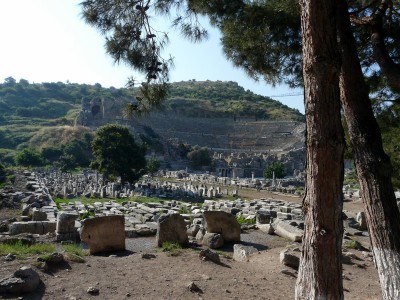
Did you know that the term "meander" has its roots in the name of the river Maeander, which winds its way through the plain where the Ionian cities of Priene and Miletus formerly stood? The relentless flow of the Maeander eventually silted over the harbours of both these cities. Today, the ruins sit far inland.
At 10 a.m., it is already scorching hot when we pull into the parking lot at Priene, but fortunately we will be shaded from the sun for most of our visit. The site is situated in a pine forest on the lower slopes of Mt. Mycale, and the experience of touring Priene is almost akin to stumbling across the foundations of an old farm in a Nova Scotia forest. The ruins of Priene date back to the Greeks of the 4th century BC. Unlike many other ancient sites in Turkey, the Romans had little interest in Priene and did not build over the Greek structures. Alexander the Great visited here in 334 BC and footed the bill for part of the cost of building the Temple of Athena.
To see the stone commemorating Alexander's contribution to Priene's Temple of Apollo, you will have to visit the basement of the British Museum in London. Other finds from the Priene site are in Berlin. It is becoming clear that a distressingly large number of Turkey's ancient treasures were plundered by 19th century archeologists, while the Ottoman rulers were seemingly asleep at the switch. This barn door was firmly closed by Ataturk's government, and Turkey now has strict prohibitions and harsh penalties for removing ANYTHING from a historic site. This is a real hardship for Rick, who loves to collect rocks when we travel. I literally have to watch him like a hawk.
The climb from the parking lot to the site is steep and hot, and an elderly French woman being helped up the hill by her solicitous husband is breathing like a deep sea diver. I admire her courage but privately review my CPR technique. This is definitely not a wheelchair-accessible site.
After photographing ourselves in the intricately carved VIP seats of the large theatre, we strike off into the trees in search of the "Sanctuary of Demeter".

I am enjoying the uphill scramble through the trees until a snake slithers out from under a rock just in front of my foot. It is thin and grey and looks like a dry stick. I immediately jump to the conclusion that I have narrowly escaped an agonizing death by snakebite poisoning, and thank my lucky stars for Rick's insistence that I wear lace-up hiking shoes and socks. Suddenly, I feel much less keen on locating the Sanctuary of Demeter. We move downhill to explore the agora, the foundations of ancient houses, and the Temple of Athena (designed by Pithius, a renowned architect who also designed the Mausoleum of Helicarnassus, one of the Seven Wonders of the Ancient World).
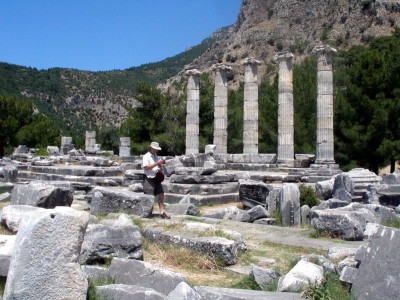
The council chamber has a beautifully-preserved altar, decorated with bull's heads and garlands. The ancient Greek inscription on a pillar at the door of the "House of Alexander" supposedly states that "only the pure, clothed in symbolic white garments, are permitted to enter the sanctuary".*
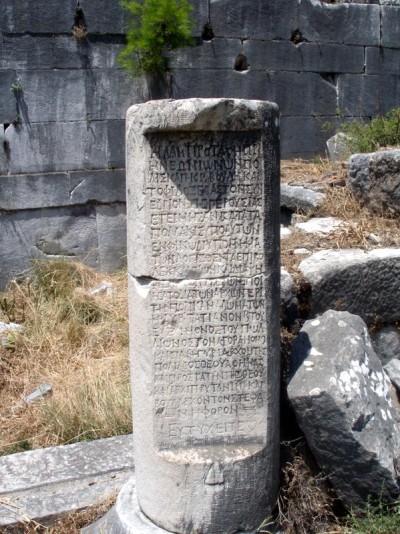
A Byzantine castle is built over the ruins of another ancient temple. There is much to see. By the time we finish, we have been hiking up and down the hill for over three hours, and we are ravenously hungry.
We drive off along narrow country roads through glorious scenery, in search of a remote restaurant that had been recommended by the owner of the Swiss rental car agency. After driving about 7 km in a southerly direction, we take a right turn to the west, past Karine. We find the restaurant at the end of the road, beside a military outpost guarded by men carrying submachine guns.
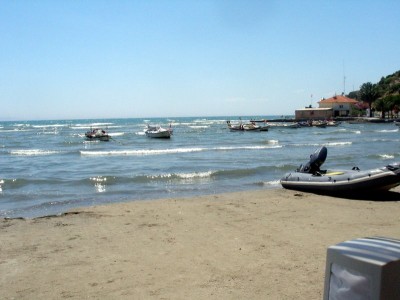
When the soldiers get lunch breaks, they must eat very well! After eating so many peanuts and cherries in the car, we really should have skipped the mezzas but we give ourselves over to gluttony and sample a thick tzaziki and a delectable eggplant salad. Our fish is grilled to perfection..crisp on the outside, moist and flavorful inside. By the time we finish our meal, we just want to go back to the boat and have a nap but instead, we head for Miletus.
This was the birthplace of the philosopher Thales, one of the "Seven Sages", who famously said "Know Thyself!" (a motto inscribed on the Temple of Apollo in Delphi). Thales apparently also said he was glad to have been born a human instead of an animal, a Greek instead of a barbarian, and a man instead of a woman, which gives you some idea of the status of women and barbarians in those days. Miletus was the birthplace of the Greek alphabet (creating it by adapting the Phoenician alphabet). In the 5th century BC , Miletus approached Ephesus in size. It later fell into the hands of the Persians, was liberated by Alexander the Great in 334 BC and remained an important city until Roman times. St. Paul met with the leaders of his fledgling congregation in Ephesus here, on his way back to Jerusalem around 57 AD.
The huge theatre at Miletus is very well preserved, and in some respects doesn't seem much different from any large stadium today.

We take a moment to imagine Paul speaking to thousands of spectators. Only a puppy is here today. For obvious reasons, I wish that I could take him home.
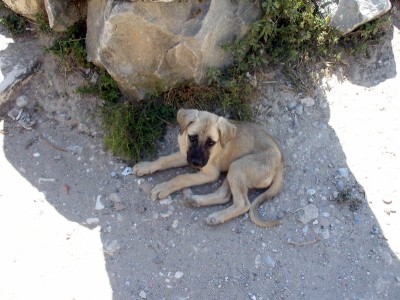
We exit through one of the "vomitoria" (not what you might be thinking...just vaulted passageways designed to let the crowds exit in an orderly fashion). We continue along a dirt path toward the ruins of the city. A signboard points out the locations of the ancient "Harbour of the Lions" (now just a dusty field), the re-erected columns of the stoa (a long colonnaded porch) a temple of Apollo and various other important buildings. This is a site where you could really let your imagination run wild, but our energy levels are flagging. We take a quick look through the windows of the 15th century "Mosque of 40 steps" (closed for restoration), walk through its spooky graveyard courtyard, then decide we have had enough.
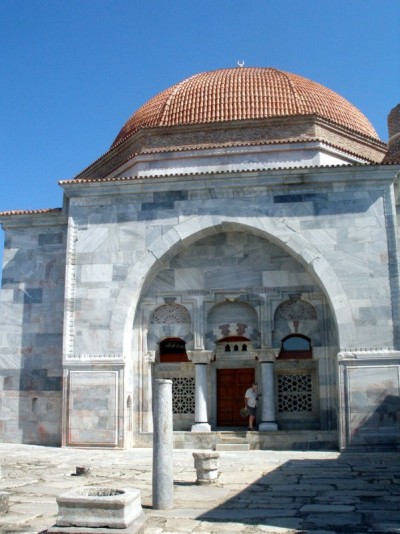
All in all it seems a bit of an anticlimax after Priene, but worth the trip if only for the translucent green onyx candle holder that I bought at the exit for only 30 lira. (I am still regretting that I did not also buy the exquisite mortar and pestle that was also on display.)
We decide to give Didyma a miss and head back toward Kusadasi. But after driving about 5 km, I read the description of Didyma in our guidebooks and decide that I really, really want to see it. Proving that he is a man of infinite patience, Rick doubles back, waves to the group of head-scarfed women that had waved to us enthusiastically the first time we passed the corner, then drives the slow 25kms to Didyma. At least it is an interesting drive, through farming country. We pass many trucks loaded with farm workers, many of whom are women wearing identical orange printed headscarves with the tails pulled across their faces, giving them the appearance of bandits.
At Didyma, Rick announces that he is "templed out". He waits in the car while I dash down the street for a quick look at the massive Temple of Apollo that once housed an oracle almost as prominent as the one at Delphi. The statues from this temple were also hauled back to jolly old England in the 19th century. From the gate, the temple looks pretty impressive even without the statues.
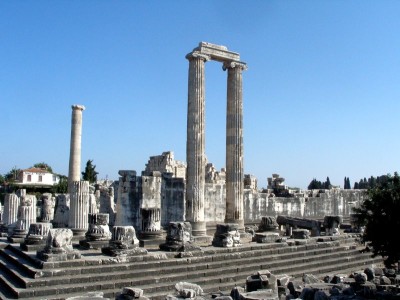
But after such a long day it is difficult to whip up any enthusiasm. (I think they call this sensory overload.) Instead of buying a ticket to go inside, I trudge back to the car and we drive back to Kusadasi, waving to our new friends at the corner as we pass them for the third time.
We have one last stop to make, at the large "Kipa" supermarket on the outskirts of Kusadaci. After loading the car with a huge load of groceries, we drive back to the marina and collapse in the cockpit. In spite of the volume of food we have bought over the past 24 hours, neither of us has the remotest interest in dinner. We turn in early, planning an early start for Ephesus in the morning.
*Historical references Blue Guide Turkey, Second Edition, 1995 and Fodors Turkey 7th Edition 2009
At 10 a.m., it is already scorching hot when we pull into the parking lot at Priene, but fortunately we will be shaded from the sun for most of our visit. The site is situated in a pine forest on the lower slopes of Mt. Mycale, and the experience of touring Priene is almost akin to stumbling across the foundations of an old farm in a Nova Scotia forest. The ruins of Priene date back to the Greeks of the 4th century BC. Unlike many other ancient sites in Turkey, the Romans had little interest in Priene and did not build over the Greek structures. Alexander the Great visited here in 334 BC and footed the bill for part of the cost of building the Temple of Athena.
To see the stone commemorating Alexander's contribution to Priene's Temple of Apollo, you will have to visit the basement of the British Museum in London. Other finds from the Priene site are in Berlin. It is becoming clear that a distressingly large number of Turkey's ancient treasures were plundered by 19th century archeologists, while the Ottoman rulers were seemingly asleep at the switch. This barn door was firmly closed by Ataturk's government, and Turkey now has strict prohibitions and harsh penalties for removing ANYTHING from a historic site. This is a real hardship for Rick, who loves to collect rocks when we travel. I literally have to watch him like a hawk.
The climb from the parking lot to the site is steep and hot, and an elderly French woman being helped up the hill by her solicitous husband is breathing like a deep sea diver. I admire her courage but privately review my CPR technique. This is definitely not a wheelchair-accessible site.
After photographing ourselves in the intricately carved VIP seats of the large theatre, we strike off into the trees in search of the "Sanctuary of Demeter".

I am enjoying the uphill scramble through the trees until a snake slithers out from under a rock just in front of my foot. It is thin and grey and looks like a dry stick. I immediately jump to the conclusion that I have narrowly escaped an agonizing death by snakebite poisoning, and thank my lucky stars for Rick's insistence that I wear lace-up hiking shoes and socks. Suddenly, I feel much less keen on locating the Sanctuary of Demeter. We move downhill to explore the agora, the foundations of ancient houses, and the Temple of Athena (designed by Pithius, a renowned architect who also designed the Mausoleum of Helicarnassus, one of the Seven Wonders of the Ancient World).

The council chamber has a beautifully-preserved altar, decorated with bull's heads and garlands. The ancient Greek inscription on a pillar at the door of the "House of Alexander" supposedly states that "only the pure, clothed in symbolic white garments, are permitted to enter the sanctuary".*

A Byzantine castle is built over the ruins of another ancient temple. There is much to see. By the time we finish, we have been hiking up and down the hill for over three hours, and we are ravenously hungry.
We drive off along narrow country roads through glorious scenery, in search of a remote restaurant that had been recommended by the owner of the Swiss rental car agency. After driving about 7 km in a southerly direction, we take a right turn to the west, past Karine. We find the restaurant at the end of the road, beside a military outpost guarded by men carrying submachine guns.

When the soldiers get lunch breaks, they must eat very well! After eating so many peanuts and cherries in the car, we really should have skipped the mezzas but we give ourselves over to gluttony and sample a thick tzaziki and a delectable eggplant salad. Our fish is grilled to perfection..crisp on the outside, moist and flavorful inside. By the time we finish our meal, we just want to go back to the boat and have a nap but instead, we head for Miletus.
This was the birthplace of the philosopher Thales, one of the "Seven Sages", who famously said "Know Thyself!" (a motto inscribed on the Temple of Apollo in Delphi). Thales apparently also said he was glad to have been born a human instead of an animal, a Greek instead of a barbarian, and a man instead of a woman, which gives you some idea of the status of women and barbarians in those days. Miletus was the birthplace of the Greek alphabet (creating it by adapting the Phoenician alphabet). In the 5th century BC , Miletus approached Ephesus in size. It later fell into the hands of the Persians, was liberated by Alexander the Great in 334 BC and remained an important city until Roman times. St. Paul met with the leaders of his fledgling congregation in Ephesus here, on his way back to Jerusalem around 57 AD.
The huge theatre at Miletus is very well preserved, and in some respects doesn't seem much different from any large stadium today.

We take a moment to imagine Paul speaking to thousands of spectators. Only a puppy is here today. For obvious reasons, I wish that I could take him home.

We exit through one of the "vomitoria" (not what you might be thinking...just vaulted passageways designed to let the crowds exit in an orderly fashion). We continue along a dirt path toward the ruins of the city. A signboard points out the locations of the ancient "Harbour of the Lions" (now just a dusty field), the re-erected columns of the stoa (a long colonnaded porch) a temple of Apollo and various other important buildings. This is a site where you could really let your imagination run wild, but our energy levels are flagging. We take a quick look through the windows of the 15th century "Mosque of 40 steps" (closed for restoration), walk through its spooky graveyard courtyard, then decide we have had enough.

All in all it seems a bit of an anticlimax after Priene, but worth the trip if only for the translucent green onyx candle holder that I bought at the exit for only 30 lira. (I am still regretting that I did not also buy the exquisite mortar and pestle that was also on display.)
We decide to give Didyma a miss and head back toward Kusadasi. But after driving about 5 km, I read the description of Didyma in our guidebooks and decide that I really, really want to see it. Proving that he is a man of infinite patience, Rick doubles back, waves to the group of head-scarfed women that had waved to us enthusiastically the first time we passed the corner, then drives the slow 25kms to Didyma. At least it is an interesting drive, through farming country. We pass many trucks loaded with farm workers, many of whom are women wearing identical orange printed headscarves with the tails pulled across their faces, giving them the appearance of bandits.
At Didyma, Rick announces that he is "templed out". He waits in the car while I dash down the street for a quick look at the massive Temple of Apollo that once housed an oracle almost as prominent as the one at Delphi. The statues from this temple were also hauled back to jolly old England in the 19th century. From the gate, the temple looks pretty impressive even without the statues.

But after such a long day it is difficult to whip up any enthusiasm. (I think they call this sensory overload.) Instead of buying a ticket to go inside, I trudge back to the car and we drive back to Kusadasi, waving to our new friends at the corner as we pass them for the third time.
We have one last stop to make, at the large "Kipa" supermarket on the outskirts of Kusadaci. After loading the car with a huge load of groceries, we drive back to the marina and collapse in the cockpit. In spite of the volume of food we have bought over the past 24 hours, neither of us has the remotest interest in dinner. We turn in early, planning an early start for Ephesus in the morning.
*Historical references Blue Guide Turkey, Second Edition, 1995 and Fodors Turkey 7th Edition 2009
Kusadasi-and a glimpse of Selcuk!
21 June 2011
Bonnie and Rick
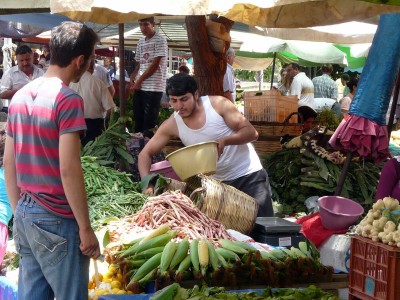
During the long run from Serce to Gumusluk, Rick puttered away at a few small tasks. In a brilliant flash of inspiration, he realized that the broken man-overboard pole would make an ideal pig stick to raise his CCA burgee to the top of Aisling's mast. He had obviously chosen the right day to do it, because shortly after we got our anchor set at Gumusluk, we were visited by Royal Cruising Club members Kit and Penny (Kwai Muli). Since we'd just had the good fortune to discover a bottle of "Baron Romano" Spanish red wine under the floorboards, we invited them aboard and had an impromptu cockpit party. The leftovers of Shima's delicious red pepper dip and crackers went very well with the wine. Later that evening, we were invited onboard Kwai Muli for baklava, tea and a dram of Metaxa (a potent Greek brandy). Having cruised this area for many years, Kit and Penny were able to give us numerous tips on islands and anchorages. By the time we climbed back into our dinghy, it was nearly midnight.
In spite of the Metaxa, we were on deck early the next morning for the 56-mile journey to Kusadasi. Gumusluk looked like it could be a nice place to settle in for a few days, but we were on a mission to get to Kusadasi while the wind was in a favorable direction. It was a pleasant change to actually be able to sail part of the way. We pulled into Kusadasi in the late afternoon and took a berth at the marina.
If a concrete jungle contest were ever to be held, Kusadasi would blow Marmaris out of the water. With its Benidorm-style apartment buildings, it is not a picturesque location. The charges at Setur marina were nearly 40 euros a day and, to add insult to injury, since our contract in Marmaris did not expire until June 15th we were paying fees to two marinas simultaneously! But we had chosen to come to Kusadasi for its proximity to Ephesus and to be fair, the marina is very nice. We were also able to take advantage of their terrific laundry service, which has no ridiculous underwear rules like the Yacht Marine laundry. We dropped off a big bag of laundry, had long hot showers and then wandered down the waterfront boulevard to the "Slip Inn" for curry night (inexpensive and delicious).
The next day (Friday) was market day in Kusadasi. We grabbed our knapsacks and headed down the boulevard, then decided to make a quick detour to the Gino Marine office to ask for a second estimate on the stern pulpit repair. Since they were willing to look at it immediately, Rick returned to the boat with the appraiser. I strolled down the boulevard killing time until a sign advertising a "Unisex Berber" caught my eye. I decided to check it out. Twenty lira for a haircut seemed too good to pass up. Like many businesses here, the shop was a family operation. The "berber" (Turkish for barber) and his cousin the esthetician were both in their early twenties; the esthetician's little girl played in the shade under the awning.
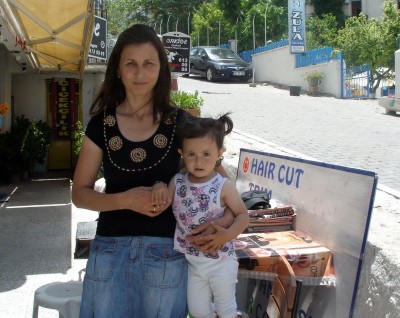
The berber's scissors flashed so quickly I could barely see the blades. Meanwhile, his cousin was realizing that I had the potential to keep her in business for the rest of the week. She frowned over my fingernails and eyebrows, then asked if she could take my moustache off. Say what? Rick, whose responsibility it surely is to keep me informed of such things, has mentioned nothing about this development! Perhaps it would have been wise to let her proceed, but I was saved by a walkie-talkie call from Rick, who was on his way. When he saw my hair, it was clear that he was trying to hide his shock. "It's kind of short" he said. It was. Very short. More Eddie Fisher than Mia Farrow. "Maybe it's because it's still a bit damp" Rick said hopefully. Maybe. But later in the week, Nancy when saw me on a Skype video call, she burst into peals of laughter. "What happened to your hair?" she asked. "I had it cut by a berber" I said. "A unisex berber". "Why on earth did you let him cut it so short?" Why indeed? For the rest of our stay, every time we passed the berber shop, they tried to convince Rick to come in and get his hair cut (eyebrows and nose hair trim included) but he was having none of it.
Back to Friday. While the berber was finishing my haircut, Rick made arrangements to rent a car from the "Swiss" rental agency, then we finally headed off to the market. The Kusadasi market is a true farmers' market (i.e. no cheap T Shirts or genuine fake watches) and the sights and smells immediately put smiles on our faces.
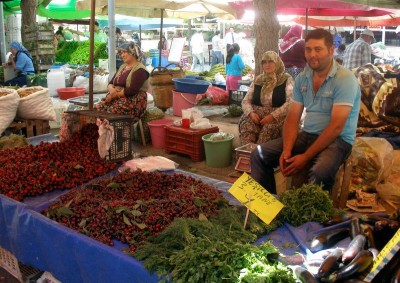
We loaded our bags with fresh artichokes, huge heads of garlic, red and green peppers, huge beefsteak tomatoes, cherry tomatoes, cucumbers, corn on the cob, cherries, strawberries, salted peanuts, peanuts coated with sesame seeds and honey; even fresh mackerel! We trudged back to the boat with our heavy bags, had a quick lunch, then retrieved our car from the agency. By 2 o'clock we were on the road to Selcuk.
Our first stop was the Ephesus museum; where a re-creation of one of the terrace houses of Ephesus really captured our imaginations (perhaps because the man depicted reclining on a sofa eating grapes reminded us so much of our friend Bruce). Who could forget the statue of Priapus (oh my!) or the model of the Temple of Artemis, one of the seven wonders of the ancient world (of which a single pillar remains standing, in a field outside Selcuk). A group of university students from Arizona, travelling in the footsteps of Paul, was most interested in a Hound of the Baskervilles -sized guard dog in the courtyard.
Next we drove up the mountainside to the house of the Virgin Mary, or "Meryemana" as she is known to Muslims. Legend says that Mary came to Ephesus with the disciple John, and the visions of a 19th century nun led clergy to the foundations of this house. I suppose it is possible that Mary lived here, or at least near here. In any case, the setting is beautiful and tranquil. A nun was reading quietly in a corner of the chapel. Each visitor is permitted only two candles and I decided to light one for Dad and one for Isabel. (It seemed appropriate that the central word in the embroidered altar cloth was "Isa," but I later learned that this is the Turkish name for Jesus.) On a wall outside the chapel, bits of rags with prayers and wishes written on them were tied to a frame.

Of the ones written in English, some were poignant ("Please me get better from my surgery) some were the sort of wishes I would make myself ("Please keep my family safe, please let my children have happy lives") and some were humorous ("Please let H lose weight!").
Our last stop of the day was Sirince, which was a Greek village up until the population exchange of 1923. It is a picturesque place, with rows of two-story houses set on a hillside and tiny shops selling handiwork and local delicacies. Although described as one of Turkey's wealthiest villages, you see a different picture if you dig behind the scenes. As we walked through the town, a woman wearing the baggie cotton pants, printed blouse and headscarf that are typical in this region approached us and motioned us up the hill. "Antique maison" she said, "photos". We followed her uphill through narrow streets to an old house in a sad state of disrepair, through a courtyard littered with rubbish and past a donkey in a stall. We removed our shoes in a dark entryway that smelled strongly of donkey, then climbed a rickety staircase to a small bedroom with three bedrolls on the floor and a grimy casement window overlooking the town. She opened the window and motioned at the town..."Photos". She disappeared briefly, then reappeared with a bag of tablecloths and runners. Clearly we had no choice but to buy one, so I chose a small tablecloth and paid the price she asked (10 lira). As we left, a dramatic thunder and lightning storm began and she quickly pulled her threadbare washing from the clothesline strung outside her door. I suspect her life is not an easy one. I wish I had paid more for the tablecloth.
We ended the day with a cockpit meal of mackerel, corn on the cob and fresh tomatoes, then tumbled into bed to rest up for the next day's road trip, to Priene, Miletus and Didyma.
Cruisers Notes
Gumusluk has limited room but is an attractive anchorage. We anchored in 24 feet; bottom was rock, weed and some sand. Wifi from restaurants ashore. Ruins of ancient Myndus are ashore. Imray guide says that water and electricity are available at the dock but we did not check it out. Minibus service to Bodrum.
Kusadasi is a busy tourist town, but a great base from which to see some of Turkish's best sites. Ephesus, Priene, Miletus, Didym and Pammukale are all accessible from here. (Alternately, if you are cruising Greek waters and do not want to buy a cruising permit for Turkey, you can anchor at Samos and take a ferry across to Kusadasi for roughly 40 euros/person.) The fees at Setur marina include electricity, water and wifi. Fuel, chandleries, repair services and provisions readily available. A large selection of reasonably-priced restaurants are within walking distance. The marina has a swimming pool with a fee of 5 lira per person charged. In June 2011, the cost to wash, dry and iron a large load of laundry was 15 lira (underwear welcomed. Underwear even ironed!) There is a large Kipa store just outside town on the road to Selcuk. Excellent vegetable market on Fridays.
We rented a car from the "Swiss" rental car agency, but tours to a variety of sites are also available from tourist agencies. When you work out the cost comparison, don't forget to factor in fuel, which is extremely expensive.
In spite of the Metaxa, we were on deck early the next morning for the 56-mile journey to Kusadasi. Gumusluk looked like it could be a nice place to settle in for a few days, but we were on a mission to get to Kusadasi while the wind was in a favorable direction. It was a pleasant change to actually be able to sail part of the way. We pulled into Kusadasi in the late afternoon and took a berth at the marina.
If a concrete jungle contest were ever to be held, Kusadasi would blow Marmaris out of the water. With its Benidorm-style apartment buildings, it is not a picturesque location. The charges at Setur marina were nearly 40 euros a day and, to add insult to injury, since our contract in Marmaris did not expire until June 15th we were paying fees to two marinas simultaneously! But we had chosen to come to Kusadasi for its proximity to Ephesus and to be fair, the marina is very nice. We were also able to take advantage of their terrific laundry service, which has no ridiculous underwear rules like the Yacht Marine laundry. We dropped off a big bag of laundry, had long hot showers and then wandered down the waterfront boulevard to the "Slip Inn" for curry night (inexpensive and delicious).
The next day (Friday) was market day in Kusadasi. We grabbed our knapsacks and headed down the boulevard, then decided to make a quick detour to the Gino Marine office to ask for a second estimate on the stern pulpit repair. Since they were willing to look at it immediately, Rick returned to the boat with the appraiser. I strolled down the boulevard killing time until a sign advertising a "Unisex Berber" caught my eye. I decided to check it out. Twenty lira for a haircut seemed too good to pass up. Like many businesses here, the shop was a family operation. The "berber" (Turkish for barber) and his cousin the esthetician were both in their early twenties; the esthetician's little girl played in the shade under the awning.

The berber's scissors flashed so quickly I could barely see the blades. Meanwhile, his cousin was realizing that I had the potential to keep her in business for the rest of the week. She frowned over my fingernails and eyebrows, then asked if she could take my moustache off. Say what? Rick, whose responsibility it surely is to keep me informed of such things, has mentioned nothing about this development! Perhaps it would have been wise to let her proceed, but I was saved by a walkie-talkie call from Rick, who was on his way. When he saw my hair, it was clear that he was trying to hide his shock. "It's kind of short" he said. It was. Very short. More Eddie Fisher than Mia Farrow. "Maybe it's because it's still a bit damp" Rick said hopefully. Maybe. But later in the week, Nancy when saw me on a Skype video call, she burst into peals of laughter. "What happened to your hair?" she asked. "I had it cut by a berber" I said. "A unisex berber". "Why on earth did you let him cut it so short?" Why indeed? For the rest of our stay, every time we passed the berber shop, they tried to convince Rick to come in and get his hair cut (eyebrows and nose hair trim included) but he was having none of it.
Back to Friday. While the berber was finishing my haircut, Rick made arrangements to rent a car from the "Swiss" rental agency, then we finally headed off to the market. The Kusadasi market is a true farmers' market (i.e. no cheap T Shirts or genuine fake watches) and the sights and smells immediately put smiles on our faces.

We loaded our bags with fresh artichokes, huge heads of garlic, red and green peppers, huge beefsteak tomatoes, cherry tomatoes, cucumbers, corn on the cob, cherries, strawberries, salted peanuts, peanuts coated with sesame seeds and honey; even fresh mackerel! We trudged back to the boat with our heavy bags, had a quick lunch, then retrieved our car from the agency. By 2 o'clock we were on the road to Selcuk.
Our first stop was the Ephesus museum; where a re-creation of one of the terrace houses of Ephesus really captured our imaginations (perhaps because the man depicted reclining on a sofa eating grapes reminded us so much of our friend Bruce). Who could forget the statue of Priapus (oh my!) or the model of the Temple of Artemis, one of the seven wonders of the ancient world (of which a single pillar remains standing, in a field outside Selcuk). A group of university students from Arizona, travelling in the footsteps of Paul, was most interested in a Hound of the Baskervilles -sized guard dog in the courtyard.
Next we drove up the mountainside to the house of the Virgin Mary, or "Meryemana" as she is known to Muslims. Legend says that Mary came to Ephesus with the disciple John, and the visions of a 19th century nun led clergy to the foundations of this house. I suppose it is possible that Mary lived here, or at least near here. In any case, the setting is beautiful and tranquil. A nun was reading quietly in a corner of the chapel. Each visitor is permitted only two candles and I decided to light one for Dad and one for Isabel. (It seemed appropriate that the central word in the embroidered altar cloth was "Isa," but I later learned that this is the Turkish name for Jesus.) On a wall outside the chapel, bits of rags with prayers and wishes written on them were tied to a frame.

Of the ones written in English, some were poignant ("Please me get better from my surgery) some were the sort of wishes I would make myself ("Please keep my family safe, please let my children have happy lives") and some were humorous ("Please let H lose weight!").
Our last stop of the day was Sirince, which was a Greek village up until the population exchange of 1923. It is a picturesque place, with rows of two-story houses set on a hillside and tiny shops selling handiwork and local delicacies. Although described as one of Turkey's wealthiest villages, you see a different picture if you dig behind the scenes. As we walked through the town, a woman wearing the baggie cotton pants, printed blouse and headscarf that are typical in this region approached us and motioned us up the hill. "Antique maison" she said, "photos". We followed her uphill through narrow streets to an old house in a sad state of disrepair, through a courtyard littered with rubbish and past a donkey in a stall. We removed our shoes in a dark entryway that smelled strongly of donkey, then climbed a rickety staircase to a small bedroom with three bedrolls on the floor and a grimy casement window overlooking the town. She opened the window and motioned at the town..."Photos". She disappeared briefly, then reappeared with a bag of tablecloths and runners. Clearly we had no choice but to buy one, so I chose a small tablecloth and paid the price she asked (10 lira). As we left, a dramatic thunder and lightning storm began and she quickly pulled her threadbare washing from the clothesline strung outside her door. I suspect her life is not an easy one. I wish I had paid more for the tablecloth.
We ended the day with a cockpit meal of mackerel, corn on the cob and fresh tomatoes, then tumbled into bed to rest up for the next day's road trip, to Priene, Miletus and Didyma.
Cruisers Notes
Gumusluk has limited room but is an attractive anchorage. We anchored in 24 feet; bottom was rock, weed and some sand. Wifi from restaurants ashore. Ruins of ancient Myndus are ashore. Imray guide says that water and electricity are available at the dock but we did not check it out. Minibus service to Bodrum.
Kusadasi is a busy tourist town, but a great base from which to see some of Turkish's best sites. Ephesus, Priene, Miletus, Didym and Pammukale are all accessible from here. (Alternately, if you are cruising Greek waters and do not want to buy a cruising permit for Turkey, you can anchor at Samos and take a ferry across to Kusadasi for roughly 40 euros/person.) The fees at Setur marina include electricity, water and wifi. Fuel, chandleries, repair services and provisions readily available. A large selection of reasonably-priced restaurants are within walking distance. The marina has a swimming pool with a fee of 5 lira per person charged. In June 2011, the cost to wash, dry and iron a large load of laundry was 15 lira (underwear welcomed. Underwear even ironed!) There is a large Kipa store just outside town on the road to Selcuk. Excellent vegetable market on Fridays.
We rented a car from the "Swiss" rental car agency, but tours to a variety of sites are also available from tourist agencies. When you work out the cost comparison, don't forget to factor in fuel, which is extremely expensive.
An Evening in Serce
13 June 2011 | Off Kusadaci
Bonnie
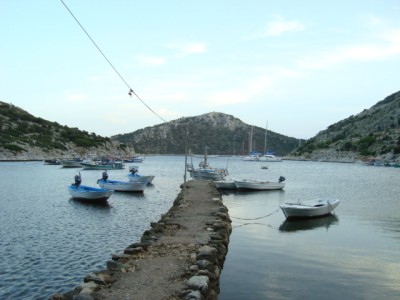
As a result of the "incident" at the dock, it is early afternoon before we sail away from Marmaris. We could have predicted the weather conditions without even looking at a forecast: almost no wind, and what little wind there is would be on the nose. Our intention is to spend the first night at anchor off the Greek island of Symi- a somewhat risky proposition since, if we are spotted by the coast guard and required to check in to Greece, we will forfeit our Turkish cruising permit and have to purchase a new one at a considerable expense when we re-enter Turkey. Rick argues that since we have no intention of setting foot on Greek soil, it should not be a problem. I worry that the huge Canadian flag on our stern could be a magnet for a zealous Greek official. In the end, it becomes a moot point. The light winds on the nose gradually become brisk winds on the nose and we decide to tuck into Serce Limani.
This long deep bay, roughly 25 miles southwest of Marmaris, is the site of an 11th-century wreck. There is a small restaurant on shore and the proprietor of the restaurant reportedly offers guided tours to Greek ruins nearby. As we enter the bay, we are met by a man rowing a small skiff. Predictably, he tells us that the mooring balls are free if we eat in the restaurant. "How much does it cost to eat in your restaurant?" I ask. "It depends" he says. "If you eat a little, it costs a little. If you eat a lot, it costs a lot." Eventually I manage to extract the information that a meal of fish costs 30 lira and chicken costs 25 lira. This is essential information, since, due to our distraction over the "incident", we have foolishly sailed away from Yacht Marine without visiting the cash machine and have a grand total of 120 lira between us.
Tying up to the mooring ball is a quick and painless process, but things fall apart when we look for a long stern line to be tied to a rock ashore. Still a little disorganized in spite of 10 full days of preparation, we rummage through lockers, find the line, manage to tangle it and when it is finally untangled realize it is not long enough. After a bit more rummaging we find a second line and also manage to tangle that one. Our host, Hassan, is clearly finding our bumbling quite amusing. "Take your time" he says. "I am not in a rush." By the time we have the boat in place, he seems to have decided he likes us, because he tells us that we can have the mooring for free even if we do not eat in the restaurant.
Within minutes, a second skiff approaches, with a man and his young son aboard. The boat is loaded with lovely tablecloths, rugs and shirts. I bargain on a cream tablecloth with delicate blue embroidery and settle on a price of 35 lira. I am feeling very pleased with myself until I realize that I have just bargained away 30% of our available cash! Luckily, Rick finds some euros tucked into the back of his wallet so dinner is still a possibility.
At 7.30, Rick rows us over to the small beach. We walk along a narrow path to the restaurant, underneath a rocky hillside of olive trees, eucalyptus trees and scrubby brush. The sound of bleating goats drifts downhill. A stout woman struggles along the hillside carrying a heavy sack on her shoulder...she seems to be collecting greens.
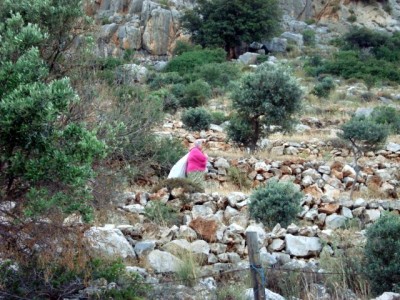
We step carefully because the path is strewn with goat droppings and cow patties. Or to be more accurate, bull patties, because we can see the bull in a field as we pass. Two puppies dash past us, and there are two more inside the restaurant. They are almost exactly the same size as our dog Shakespeare was the first time we saw him, and for the thousandth time I feel the little ache that arrives when I realize he is gone forever. The puppies gallop across the floor, chasing two kittens that have appeared from the back of the restaurant. It is a veritable menagerie, especially if you count the numerous species of moths and insects that are flying around the restaurant (which does have a grass roof, but does not have walls).
Hassan leads us to a platter of raw fish and we make our choices, then settle at a table overlooking the water to enjoy a cold Efes with a plate of homemade mezzas and delicious coarse bread. Only one other table is occupied, by a group from the UK and Dubai, who are just finishing a two-week charter. The husbands have had a wonderful vacation; the wives, not so much. Two large and persistent moths are determined to land in the hair of the woman from Dubai; there is a wasp in my beer and a huge dragonfly swoops past. A giant, brilliant green, monster-size grasshopper (about three inches long and a dead ringer for the ones the boys in St. Lucia make from palm leaves) lands on the table. There is a puppy under my chair. Rick jumps up and brushes a two-inch centipede off his leg. This is rural dining at its best.
Hassan appears from the back and flicks a switch that triggers a flashing string of Christmas lights framing a Canadian flag in a box. The theme from "The Spy Who Loved Me" blasts from the stereo. I burst into laughter and Hassan is clearly very pleased with himself. Our meals are delicious, served with salad, rice and delicious home-cut french fries, crisp and perfect. The meal ends with a plate of figs, apples and Turkish Delight. "A gift" says Hassan. Thankfully, we have enough money to pay the bill and leave a small tip. "My friends" says Hassan "You are not rich, but you are good people". A true compliment. He invites us to come for tea the next morning, or any time we are in the neighbourhood. "Not for business, not in the restaurant" he says. "In the house, for friendship." We have to leave early the next morning, but perhaps we will be back this way some day.
As we leave the restaurant, the crescent moon is rising over the trees and the strains of "Marcia Alla Turca" follow us along the path. "Oh look" said Rick, "It's the Islamic moon!" Perhaps we are not quite ready to leave Turkey after all.
This long deep bay, roughly 25 miles southwest of Marmaris, is the site of an 11th-century wreck. There is a small restaurant on shore and the proprietor of the restaurant reportedly offers guided tours to Greek ruins nearby. As we enter the bay, we are met by a man rowing a small skiff. Predictably, he tells us that the mooring balls are free if we eat in the restaurant. "How much does it cost to eat in your restaurant?" I ask. "It depends" he says. "If you eat a little, it costs a little. If you eat a lot, it costs a lot." Eventually I manage to extract the information that a meal of fish costs 30 lira and chicken costs 25 lira. This is essential information, since, due to our distraction over the "incident", we have foolishly sailed away from Yacht Marine without visiting the cash machine and have a grand total of 120 lira between us.
Tying up to the mooring ball is a quick and painless process, but things fall apart when we look for a long stern line to be tied to a rock ashore. Still a little disorganized in spite of 10 full days of preparation, we rummage through lockers, find the line, manage to tangle it and when it is finally untangled realize it is not long enough. After a bit more rummaging we find a second line and also manage to tangle that one. Our host, Hassan, is clearly finding our bumbling quite amusing. "Take your time" he says. "I am not in a rush." By the time we have the boat in place, he seems to have decided he likes us, because he tells us that we can have the mooring for free even if we do not eat in the restaurant.
Within minutes, a second skiff approaches, with a man and his young son aboard. The boat is loaded with lovely tablecloths, rugs and shirts. I bargain on a cream tablecloth with delicate blue embroidery and settle on a price of 35 lira. I am feeling very pleased with myself until I realize that I have just bargained away 30% of our available cash! Luckily, Rick finds some euros tucked into the back of his wallet so dinner is still a possibility.
At 7.30, Rick rows us over to the small beach. We walk along a narrow path to the restaurant, underneath a rocky hillside of olive trees, eucalyptus trees and scrubby brush. The sound of bleating goats drifts downhill. A stout woman struggles along the hillside carrying a heavy sack on her shoulder...she seems to be collecting greens.

We step carefully because the path is strewn with goat droppings and cow patties. Or to be more accurate, bull patties, because we can see the bull in a field as we pass. Two puppies dash past us, and there are two more inside the restaurant. They are almost exactly the same size as our dog Shakespeare was the first time we saw him, and for the thousandth time I feel the little ache that arrives when I realize he is gone forever. The puppies gallop across the floor, chasing two kittens that have appeared from the back of the restaurant. It is a veritable menagerie, especially if you count the numerous species of moths and insects that are flying around the restaurant (which does have a grass roof, but does not have walls).
Hassan leads us to a platter of raw fish and we make our choices, then settle at a table overlooking the water to enjoy a cold Efes with a plate of homemade mezzas and delicious coarse bread. Only one other table is occupied, by a group from the UK and Dubai, who are just finishing a two-week charter. The husbands have had a wonderful vacation; the wives, not so much. Two large and persistent moths are determined to land in the hair of the woman from Dubai; there is a wasp in my beer and a huge dragonfly swoops past. A giant, brilliant green, monster-size grasshopper (about three inches long and a dead ringer for the ones the boys in St. Lucia make from palm leaves) lands on the table. There is a puppy under my chair. Rick jumps up and brushes a two-inch centipede off his leg. This is rural dining at its best.
Hassan appears from the back and flicks a switch that triggers a flashing string of Christmas lights framing a Canadian flag in a box. The theme from "The Spy Who Loved Me" blasts from the stereo. I burst into laughter and Hassan is clearly very pleased with himself. Our meals are delicious, served with salad, rice and delicious home-cut french fries, crisp and perfect. The meal ends with a plate of figs, apples and Turkish Delight. "A gift" says Hassan. Thankfully, we have enough money to pay the bill and leave a small tip. "My friends" says Hassan "You are not rich, but you are good people". A true compliment. He invites us to come for tea the next morning, or any time we are in the neighbourhood. "Not for business, not in the restaurant" he says. "In the house, for friendship." We have to leave early the next morning, but perhaps we will be back this way some day.
As we leave the restaurant, the crescent moon is rising over the trees and the strains of "Marcia Alla Turca" follow us along the path. "Oh look" said Rick, "It's the Islamic moon!" Perhaps we are not quite ready to leave Turkey after all.
| Vessel Name: | Aisling I |
| Vessel Make/Model: | Slocum 43 |
| Hailing Port: | Halifax, NS, Canada |
| Crew: | Rick and Bonnie Salsman |
| About: | |
| Extra: | |
| Social: |
Aisling I's Photos - Aisling I (Main)
About Aisling 1
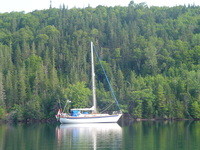
Who: Rick and Bonnie Salsman
Port: Halifax, NS, Canada
Quick Links
- Miscellaneous
- Greece-other
- Croatia and Montenegro 2012
- Sicily 2011-2014
- Italy (Mainland) 2012
- Weather and Technical
- Turkey
- Greece-Aegean
- Syracuse 2009
- Tunisia
- Malta
- Greece Ionian & Gulf of Corinth
- Sicily 2008
- Corsica and Sardinia
- Southern France
- Transatlantic part 2-Azores to Baiona
- Azores 2007
- South Spain & Balearics-2008
- South Spain & Gibraltar 2007
- Portugal 2007
- Atlantic Spain
- Transatlantic part 1-Halifax to Azores
- Previous Trips
- pre departure
- Show All Posts








